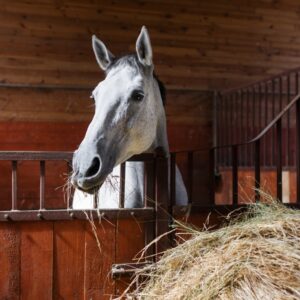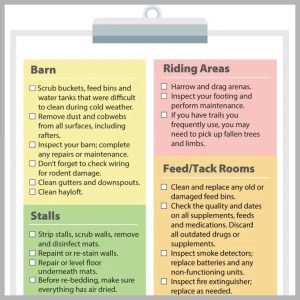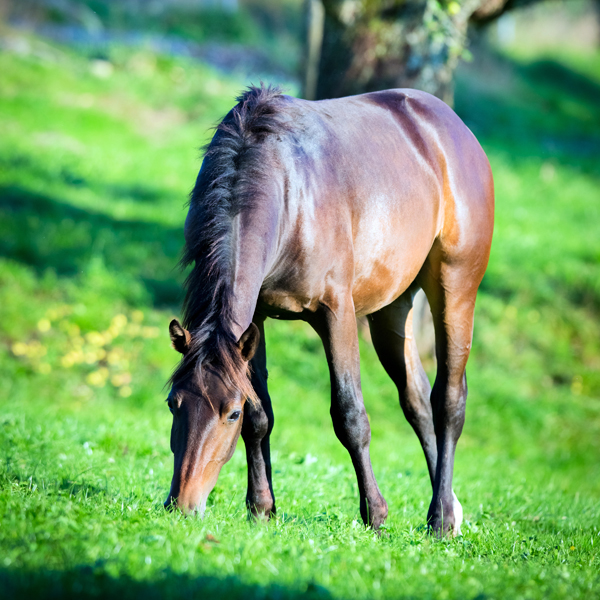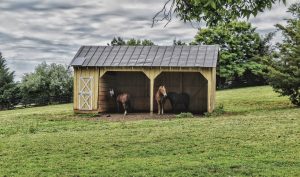
Horse Care Tips & Tricks in Fluctuating Weather – Part 1
Caring for your equine partner is a year-round commitment that requires regular adjustment to their changing needs. When the weather changes—especially in fall and spring, when temperatures, rainfall, pasture growth, and other conditions can fluctuate rapidly—it can present unique challenges both for horses and for horse owners’ management programs. Fortunately, there are ways you can help your horse stay healthy and comfortable through seasonal transitions and unpredictable weather patterns.
Two top tips: plan ahead and make changes to your horse’s routine and feed gradually to help them adjust.
Create a Monthly Horse Care Checklist
 Start by creating a seasonal horse care checklist. Having a checklist—and posting it in the barn, where it’s easy to read through and update as needed—also will help your management program stay on schedule and be prepared during changing weather. That can contribute to better overall health for your horse and lower stress for you, too. Things to include on your checklist:
Start by creating a seasonal horse care checklist. Having a checklist—and posting it in the barn, where it’s easy to read through and update as needed—also will help your management program stay on schedule and be prepared during changing weather. That can contribute to better overall health for your horse and lower stress for you, too. Things to include on your checklist:
- Regular vet check-ups
- Vaccination schedules
- Parasite control measures
- Hoof care appointments
- Equine dental health appointments
- Shelter and fence maintenance
- Feed and water system checks
- Pasture assessment
- Blanket cleaning, reproofing, and repairs
Monitor Water Intake
One of the most critical aspects of horse care, regardless of the season, is ensuring your horse has adequate water. Proper hydration helps maintain a healthy digestive tract and can prevent digestive issues.
In both hot and cold weather, horses may be at risk of dehydration, which can lead to serious health issues, including an increased risk of colic. It’s vital to ensure your horse has access to clean water at all times. When temperatures fluctuate, step up water checks to make sure that your horse’s water supply hasn’t unexpectedly dropped (due to evaporation or increased drinking in hot weather, for example) or frozen during a hard cold snap. During excessive rainfall or an unexpected freeze, also check footing around water sources to make sure horses can safely reach the water they need. Keep an eye on herd dynamics, too, to be sure all horses are getting ample access to water and that none is being kept away from an outdoor water source by bullying.
In hot weather, provide cool, fresh water. In cold weather, offering lukewarm water can encourage a horse to drink. Whatever the prevailing season, consider supplementing your horse’s diet with an electrolyte like Summer Games® Electrolyte to encourage drinking and support proper hydration. Summer Games helps replace electrolytes lost through sweating but also encourages a thirst response that also can be helpful if a horse is hesitant to drink in winter.
Adjust Feeding and Turnout Practices

As ambient temperatures fluctuate, your horse’s nutritional needs and pasture turnout might also need adjustment.
- During cold spells, increase forage to help your horse generate body heat.
- In hot weather, consider pasture turnout during cooler parts of the day to prevent heat stress.
- Monitor grass quality as seasons change and adjust grazing time accordingly. Remember to make seasonal transitions, such as the switch from summer pasture to winter hay, gradually.
Temperature shifts and weather conditions can also affect the sugar content in grass, which can affect the best timing for your horse’s turnout on pasture. Normally, experts recommend allowing horses who are insulin-resistant or at risk of laminitis to graze no later than 10 a.m., because the sugar content in grass increases with sunlight during the day (heavy cloud cover can make that process slower, though, and might allow you to leave a horse out longer). But if the nighttime temperature sinks to 40° or lower after a warm, 60° day, pasture grass will stop growing overnight and will retain higher levels of sugar the following morning—meaning at-risk horses should stay in longer.
Weather changes also can affect the sugar level in hay, so it’s good to keep in touch with your hay provider for details about the hay your horse is eating. For example, research has shown that hay baled after a two-week period of cloudy weather is significantly lower in sugar.
Horses who are insulin-resistant, have equine metabolic syndrome, or have a history of laminitis require particularly careful management. Consult your veterinarian about supplementing with InsulinWise® powder or pellets, which can support normal metabolic function and health insulin levels.
Know Your Pasture Plants—and Check Them
Weather fluctuations can also stress pasture grass and weeds, putting your horse at risk. Both freezing temps and drought can lower grass quality. But freeze- or drought-stressed pasture grass and weeds also can be harmful. For example, plants like sorghum-sudangrass and johnsongrass can cause cyanide poisoning after a frost, and pigweed’s higher nitrogen levels after a frost can also be toxic.
Also notice plants and trees growing around the periphery that might fall or be blown into your horse’s pasture during a storm. Wilted maple, cherry, and chokecherry can be poisonous to a curious or bored horse that finds a branch blow or dropped into their paddock. Black walnut also is a deadly threat if horses eat it, drink water contaminated by it, or stand on black walnut shavings.
Make it a habit to your pasture, fence lines, water sources after storms or a quick weather change.
Provide Adequate Shelter
 Having a sturdy, well-sited, and safely maintained shelter will help protect your horse from almost anything Mother Nature throws at them. A run-in shed or well ventilated (but not drafty) stall that your horse can access at all times will provide shade on an unexpectedly hot day, a place to get out of the cold wind or rain from a fast-moving front, and even shelter from a sudden hailstorm. Natural shelter like a stand of trees or a hedge that serves as a windbreak can help protect from a quick shift in weather, but make sure that whatever shelter your horse has is in good repair, easy for them to access, and can keep them dry and out of the wind in inclement weather.
Having a sturdy, well-sited, and safely maintained shelter will help protect your horse from almost anything Mother Nature throws at them. A run-in shed or well ventilated (but not drafty) stall that your horse can access at all times will provide shade on an unexpectedly hot day, a place to get out of the cold wind or rain from a fast-moving front, and even shelter from a sudden hailstorm. Natural shelter like a stand of trees or a hedge that serves as a windbreak can help protect from a quick shift in weather, but make sure that whatever shelter your horse has is in good repair, easy for them to access, and can keep them dry and out of the wind in inclement weather.
Remember that horses can tolerate cold better than heat and humidity, but they still need protection from extreme conditions.
Watch for Signs of Stress
Fluctuating weather can be stressful for any horse. Keep an eye out for signs of discomfort or health issues, such as
- Changes in eating or drinking habits
- Lethargy, depression, or unusual behavior
- Signs of colic or other digestive issues
- Excessive sweating or shivering
Early detection and intervention can prevent minor issues from becoming major health concerns. In case of heat-related stress, know how to cool your horse properly and quickly, as heat stress can be deadly.
To support your horse’s overall health and stress response during weather changes, consider adding Elevate® Maintenance Powder to their diet. This natural vitamin E supplement supports muscle and nerve function, and acts as an antioxidant, which can be particularly beneficial during times of stress or increased physical demands.
Article written by KPP staff.
Copyright (C) 2023 Kentucky Performance Products, LLC. All rights reserved.
The Horse That Matters to You Matters to Us®
Since 1998, Kentucky Performance Products has simplified a horse owner’s search for research-proven nutritional horse supplements that meet the challenges facing modern horses. Our horse supplements target specific nutritional needs and are formulated to complement today’s feeds, thus safeguarding against over-supplementation. Each product is scientifically formulated and made with high-quality ingredients at certified manufacturing facilities. Kentucky Performance Products is proud to offer a quality assurance promise backed by a money-back guarantee. Kentucky Performance Products brings you horse supplements you can count on because the horse that matters to you, matters to us. KPPusa.com


